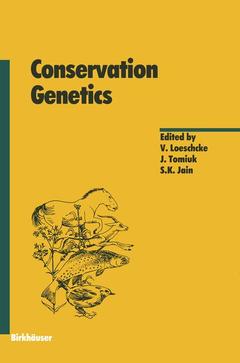Conservation Genetics, Softcover reprint of the original 1st ed. 1994 Coll. Experientia Supplementum, Vol. 68
Langue : Français
Coordonnateurs : Loeschcke V., Tomiuk J., Jain S.K.

It follows naturally from the widely accepted Darwinian dictum that failures of populations or of species to adapt and to evolve under changing environments will result in their extinction. Population geneti cists have proclaimed a centerstage role in developing conservation biology theory and applications. However, we must critically reexamine what we know and how we can make rational contributions. We ask: Is genetic variation really important for the persistence of species? Has any species become extinct because it ran out of genetic variation or because of inbreeding depression? Are demographic and environmental stochas ticity by far more important for the fate of a population or species than genetic stochasticity (genetic drift and inbreeding)? Is there more to genetics than being a tool for assessing reproductive units and migration rates? Does conventional wisdom on inbreeding and "magic numbers" or rules of thumb on critical effective population sizes (MVP estimators) reflect any useful guidelines in conservation biology? What messages or guidelines from genetics can we reliably provide to those that work with conservation in practice? Is empirical work on numerous threatened habitats and taxa gathering population genetic information that we can use to test these guidelines? These and other questions were raised in the invitation to a symposium on conservation genetics held in May 1993 in pleasant surroundings at an old manor house in southern Jutland, Denmark.
I: Genetics and conservation biology.- Introductory remarks: Genetics and conservation biology.- Global issues of genetic diversity.- II: Genetic variation and fitness.- Introductory remarks.- Genetic variation and fitness: Conservation lessons from pines.- Genetic diversity and fitness in small populations.- Mutation load depending on variance in reproductive success and mating system.- Extinction risk by mutational meltdown: Synergistic effects between population regulation and genetic drift.- III: Inbreeding, population and social structure.- Introductory remarks.- Inbreeding: One word, several meanings, much confusion.- The genetic structure of metapopulations and conservation biology.- Effects of inbreeding in small plant populations: Expectations and implications for conservation.- The interaction of inbreeding depression and environmental stochasticity in the risk of extinction of small populations.- Genetic structure of a population with social structure and migration.- Guidelines in conservation genetics and the use of the population cage experiments with butterflies to investigate the effects of genetic drift and inbreeding.- IV: Molecular approaches to conservation.- Introductory remarks.- Rare alleles, MHC and captive breeding.- Andean tapaculos of the genus Scytalopus (Aves, Rhinocryptidae): A study of speciation using DNA sequence data.- Genetic distances and the setting of conservation priorities.- Multi-species risk analysis, species evaluation and biodiversity conservation.- V: Case studies.- Introductory remarks.- On genetic erosion and population extinction in plants: A case study in Scabiosa columbaria and Salvia pratensis.- Effects of releasing hatchery-reared brown trout to wild trout populations.- Genetics and demography of rare plants and patchily distributed colonizing species.- Response to environmental change: Genetic variation and fitness in Drosophila buzzatii following temperature stress.- Alternative life histories and genetic conservation.- The principles of population monitoring for conservation genetics.- VI: Genetic resource conservation.- Introductory remarks.- Optimal sampling strategies for core collections of plant genetic resources.- Conservation genetics and the role of botanical gardens.- Animal breeding and conservation genetics.- Scenarios.- Introductory remarks.- A: The genetic monitoring of primate populations for their conservation.- B: Heavy metal tolerance, plant evolution and restoration ecology.- C: Genetic conservation and plant agriculture.- D: Fragmented plant populations and their lost interactions.- E: Host-pathogen coevolution under in situ conservation.- Concluding remarks.
Date de parution : 10-2012
Ouvrage de 443 p.
Disponible chez l'éditeur (délai d'approvisionnement : 15 jours).
Prix indicatif 52,74 €
Ajouter au panierThème de Conservation Genetics :
Mots-clés :
behavior; biology; genetic information; genetics; population; genetic engineering
© 2024 LAVOISIER S.A.S.
